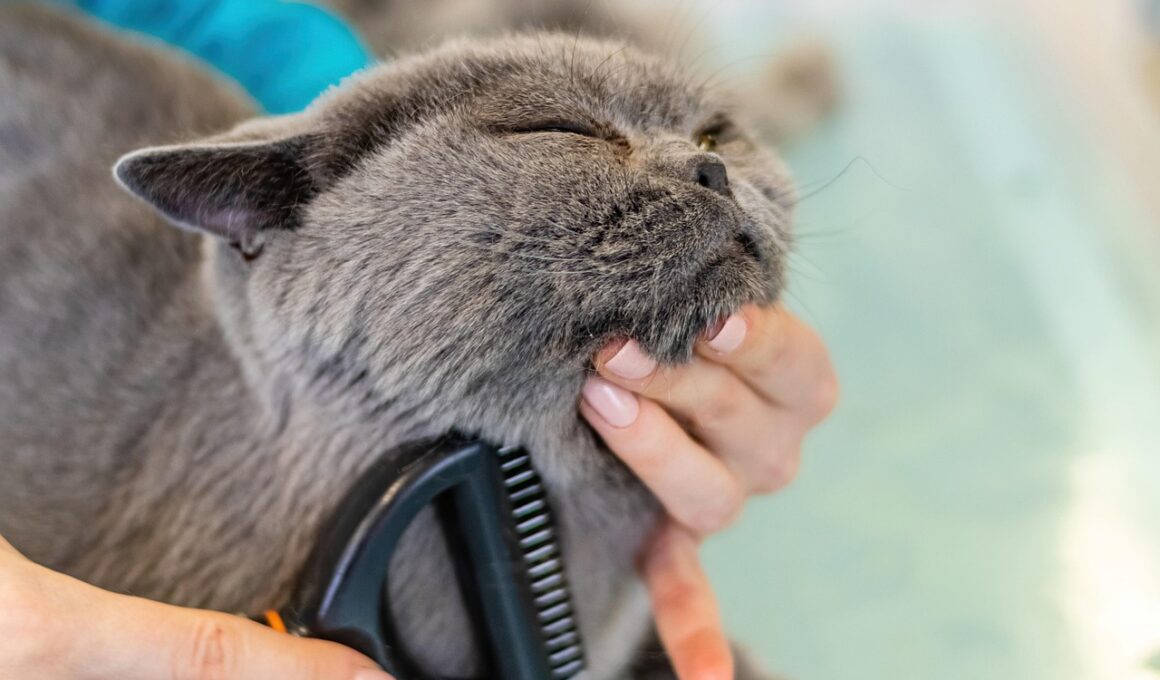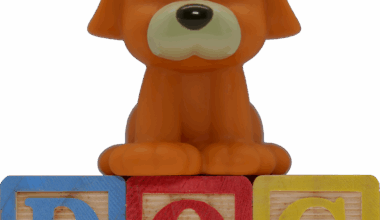The Impact of Diet on Cat Skin Health Detected During Grooming
Diet plays a vital role in the overall health of cats, and it significantly impacts skin condition. Grooming reveals issues that diet can influence, such as dryness or irritation. The skin is an invaluable indicator of a cat’s internal health, and many common issues can stem from improper nutrition. By carefully observing your feline during grooming, you can identify these health issues early. Nutritional deficiencies, particularly in essential fatty acids, can lead to problems like flaky skin or excessive shedding. Omega-3 and Omega-6 fatty acids are critical for maintaining a healthy coat and skin. Additionally, poor quality protein sources can contribute to allergies or sensitivity, ultimately manifesting as skin irritation. Not only does this require adjustments in diet, but also close attention during grooming sessions. Regular grooming can help redistribute your cat’s natural oils, promoting healthy skin. It also provides an opportunity to observe any changes. Look carefully for bumps, redness, or excessive scratching during these sessions to catch issues early. Early detection relies on routine care and dietary mindfulness for optimal skin health.
A balanced diet must encompass all necessary nutrients that contribute to a cat’s skin health. Proteins, vitamins, and minerals are essential for robust skin and fur. Ensuring the right balance of nutrients can significantly affect a cat’s overall skin condition. For instance, both Vitamin E and Zinc serve as antioxidants that protect the skin from cellular damage. Supplements such as Biotin may also enhance skin health, preventing dryness. When grooming your cat, look for clues that you might attribute to dietary insufficiencies. A shiny coat indicates proper nutrition, while a dull fur might signal a lack of essential nutrients. Similarly, certain fatty acids, when included in the diet, can lead to decreased skin inflammation. Cats suffering from food allergies might also develop skin problems, necessitating changes in their diet. As a cat owner, make sure your pet is consuming high-quality, species-appropriate food to maintain skin health. Moreover, consulting with a veterinarian can guide you in selecting the best dietary options that suit your cat’s specific needs. Comprehensive dietary assessments can aid in diagnosing various skin conditions visible during grooming sessions, supporting effective treatment.
Signs of Skin Issues During Grooming
When grooming your cat, there are specific signs that hint at underlying skin conditions. Observing your cat’s skin closely is crucial as changes may indicate dietary issues. Common visible signs during grooming include redness, rashes, or bumps on the fur. Flaky or dry skin might suggest a lack of hydration and essential fats in their diet. Flea infestations can also lead to excessive scratching, indicating potential allergic reactions connected to dietary factors. Pay attention to changes in behavior as well; increased scratching or grooming may point towards irritation. Furthermore, odor emanating from the skin can signify underlying infections that may also link back to diet. It is essential to differentiate between typical grooming behavior and signs of distress. Regular inspections and professional grooming can provide insight into your pet’s skin health. Documenting these findings can also help guide dietary adjustments, ensuring your kitty receives the appropriate nutrition. Incorporating high-quality food with essential nutrients will help avoid many issues, creating a healthy environment for your cat’s skin to thrive. Consequently, effective grooming goes beyond aesthetics; it nurtures developmental wellness.
Understanding the relationship between diet and skin health enables better preventive care. Choosing the right food for your cat should involve knowledge of their unique nutritional needs. Cats, being obligate carnivores, require a diet rich in animal proteins. This is essential for skin health as proteins contribute to collagen formation, which is vital for skin strength. Consulting with a veterinarian can help create a tailored diet plan that meets your cat’s individual requirements. Exotic proteins may also be beneficial for cats with specific dietary sensitivities. Additionally, incorporating fruits and vegetables in moderation provides essential vitamins and minerals without unnecessary fillers. Diet modifications may be gradual, introducing new foods one at a time to monitor reactions. Always check for hypoallergenic options if your cat’s grooming sessions reveal skin issues. It’s crucial to ensure the quality of ingredients in store-bought foods, selecting brands without artificial additives or preservatives. Regular grooming enables you to evaluate the effectiveness of dietary changes on skin health visually. A thoughtful approach to diet can significantly impact your cat’s skin condition and overall well-being.
Importance of Hydration
Another critical aspect of skin health directly tied to diet is hydration. Cats are notorious for not drinking enough water, which can lead to dry skin. Ensuring that your cat is well-hydrated can enhance skin elasticity and overall texture. Incorporating wet food into their diet is one way to boost hydration levels. Wet food typically contains higher moisture levels, making it easier for cats to maintain proper hydration. Moreover, consider investing in cat water fountains to encourage drinking, as many cats are drawn to running water. During grooming sessions, monitor how easily your cat’s skin bounces back after a gentle pinch. Lack of elasticity can be a clear sign of dehydration, prompting dietary adjustments. Additionally, some highly processed dry foods can contribute to dehydration, further impacting skin health. Identifying a quality food option that supports hydration can lead to improved skin conditions. Again, consulting with your veterinarian can help determine the best ways to encourage hydration through diet. Ultimately, a well-rounded approach including adequate water intake supports overall skin health.
Understanding allergies is another key factor in managing skin health through diet. Many cats develop food allergies, which can manifest as skin issues during grooming. Common allergens include beef, chicken, and dairy products. Eliminating these from your cat’s diet might alleviate skin irritations. Gradual reintroduction may help identify specific triggers that could cause skin reactions. If your cat presents with symptoms like itching, hair loss, or hot spots, conducting an elimination diet may be essential. Changes often take time, so patience is crucial during this process. Regular grooming allows you to track your cat’s response to dietary changes, observing any improvements or deteriorations in skin health. Moreover, using hypoallergenic cat foods can provide relief for sensitive skin due to allergies. Work closely with your veterinarian to create a manageable plan when addressing dietary-induced allergies. A thorough approach considering diet, grooming, and overall health will ensure that your cat remains comfortable. Remember that proper diet not only aids skin health but also contributes to your cat’s overall quality of life, creating a happier, healthier companion.
Conclusion and preventive measures
In conclusion, diet directly impacts cat skin health. Regular grooming provides valuable insights into any underlying issues that may arise due to nutritional deficiencies. Ensuring balanced nutrition, adequate hydration, and awareness of allergies is key to maintaining healthy skin in cats. Observing behavior, coat texture, and skin during grooming helps identify necessary dietary adjustments early. You can make educated decisions about your cat’s food by prioritizing quality ingredients and understanding their specific needs. Regular veterinary consultations play an essential role in ensuring optimal skin health, guiding dietary choices. Keep in mind, supplemental options like Omega fatty acids might strengthen skin barriers as well. Having a structured grooming routine will enhance both the bond with your cat and the assessment of their health. Small dietary adjustments can lead to significant changes in skin condition, helping your feline feel more comfortable and happy. Ultimately, responsible pet ownership means actively engaging in your cat’s health, ensuring a long and fulfilling life. A vigilant approach toward diet and regular grooming can enhance your cat’s well-being effectively, contributing to a beautiful and healthy life.
In summary, the diet has far-reaching implications for your cat’s skin health. Regular assessments during grooming can reveal vital signs of nutritional issues. Addressing these concerns promptly leads to better skin condition and overall wellness for your cat. Prioritizing high-quality food with essential nutrients will enhance skin resilience, reducing issues linked to common allergies. For optimal cat hygiene, a well-balanced diet and thorough grooming routine are necessary. Therefore, remain informed about dietary impacts on your pet’s skin health, actively supporting their long-term happiness. Ultimately, your observant approach will refine your cat’s grooming routine, contributing to their overall quality of life.


